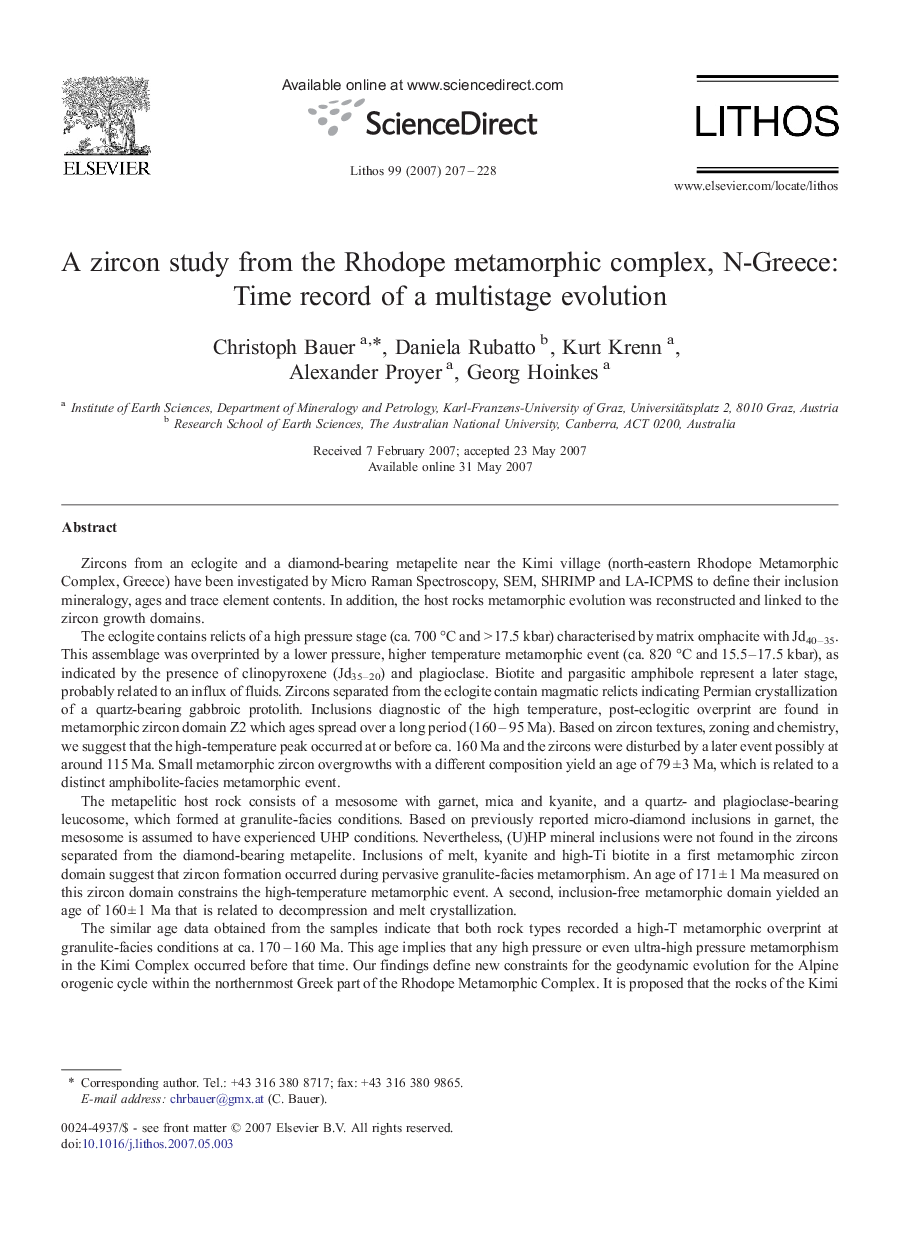| کد مقاله | کد نشریه | سال انتشار | مقاله انگلیسی | نسخه تمام متن |
|---|---|---|---|---|
| 4717694 | 1638762 | 2007 | 22 صفحه PDF | دانلود رایگان |

Zircons from an eclogite and a diamond-bearing metapelite near the Kimi village (north-eastern Rhodope Metamorphic Complex, Greece) have been investigated by Micro Raman Spectroscopy, SEM, SHRIMP and LA-ICPMS to define their inclusion mineralogy, ages and trace element contents. In addition, the host rocks metamorphic evolution was reconstructed and linked to the zircon growth domains.The eclogite contains relicts of a high pressure stage (ca. 700 °C and > 17.5 kbar) characterised by matrix omphacite with Jd40–35. This assemblage was overprinted by a lower pressure, higher temperature metamorphic event (ca. 820 °C and 15.5–17.5 kbar), as indicated by the presence of clinopyroxene (Jd35–20) and plagioclase. Biotite and pargasitic amphibole represent a later stage, probably related to an influx of fluids. Zircons separated from the eclogite contain magmatic relicts indicating Permian crystallization of a quartz-bearing gabbroic protolith. Inclusions diagnostic of the high temperature, post-eclogitic overprint are found in metamorphic zircon domain Z2 which ages spread over a long period (160 – 95 Ma). Based on zircon textures, zoning and chemistry, we suggest that the high-temperature peak occurred at or before ca. 160 Ma and the zircons were disturbed by a later event possibly at around 115 Ma. Small metamorphic zircon overgrowths with a different composition yield an age of 79 ± 3 Ma, which is related to a distinct amphibolite-facies metamorphic event.The metapelitic host rock consists of a mesosome with garnet, mica and kyanite, and a quartz- and plagioclase-bearing leucosome, which formed at granulite-facies conditions. Based on previously reported micro-diamond inclusions in garnet, the mesosome is assumed to have experienced UHP conditions. Nevertheless, (U)HP mineral inclusions were not found in the zircons separated from the diamond-bearing metapelite. Inclusions of melt, kyanite and high-Ti biotite in a first metamorphic zircon domain suggest that zircon formation occurred during pervasive granulite-facies metamorphism. An age of 171 ± 1 Ma measured on this zircon domain constrains the high-temperature metamorphic event. A second, inclusion-free metamorphic domain yielded an age of 160 ± 1 Ma that is related to decompression and melt crystallization.The similar age data obtained from the samples indicate that both rock types recorded a high-T metamorphic overprint at granulite-facies conditions at ca. 170 – 160 Ma. This age implies that any high pressure or even ultra-high pressure metamorphism in the Kimi Complex occurred before that time. Our findings define new constraints for the geodynamic evolution for the Alpine orogenic cycle within the northernmost Greek part of the Rhodope Metamorphic Complex. It is proposed that the rocks of the Kimi Complex belong to a suture zone squeezed between two continental blocks and result from a Paleo-ocean basin, which should be located further north of the Jurassic Vardar Ocean.
Journal: Lithos - Volume 99, Issues 3–4, December 2007, Pages 207–228